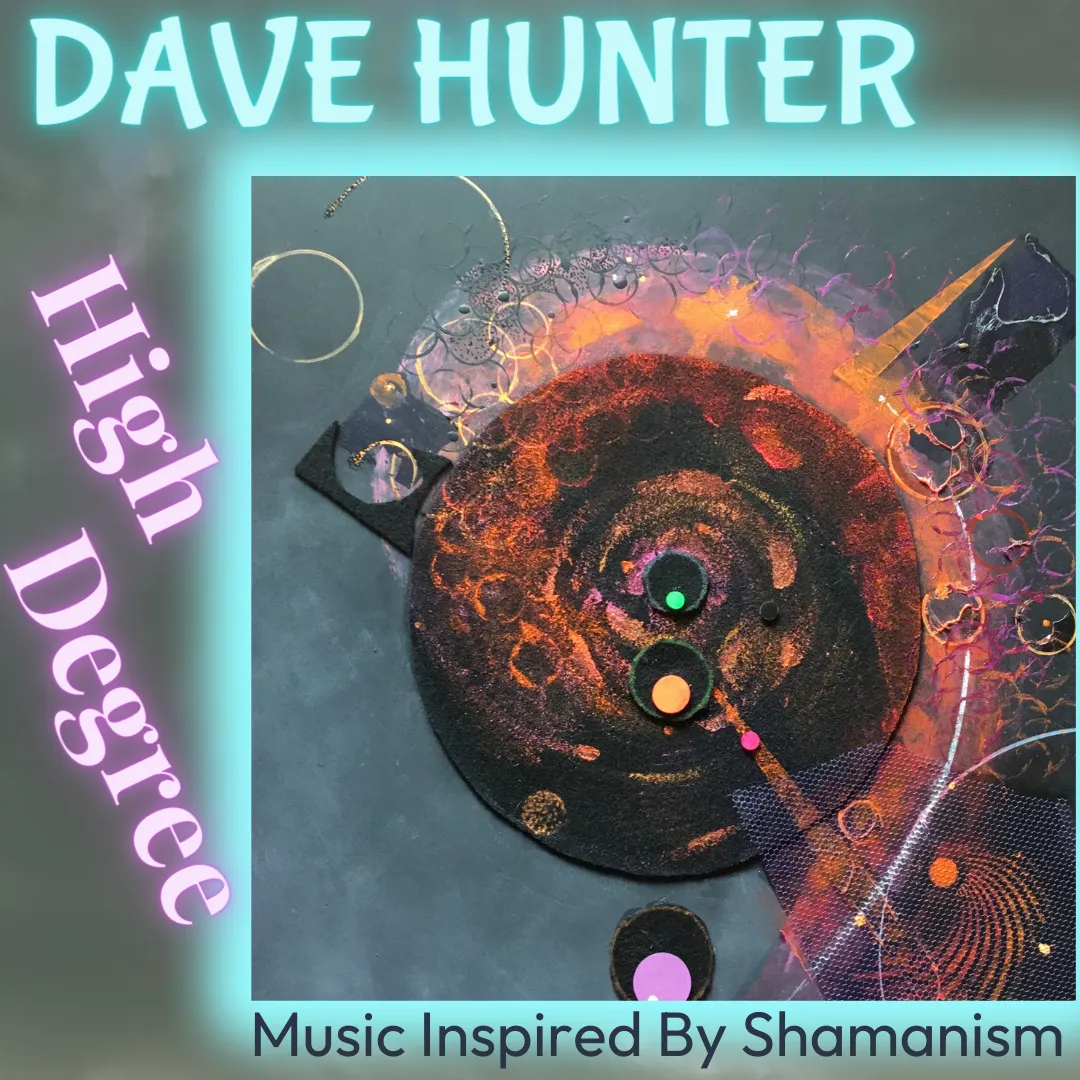High Degree
Music Inspired by Shamanism

Use my magic rope to ascend into the sky. You’ll explore night terrors, aboriginal dreaming, clever men and a bridge fraught with tests...just to name a few.
Shamanism is reported to be the world’s oldest religious practice and is widespread across the world. Even in the modern Western world, shamanic techniques have been incorporated into therapeutic psychological practices.
The technical definition of a shaman is that the shaman possesses the special ability to leave the body (spiritually or psychically) and to travel/navigate his or her way to the spirit world and then return to the body. The culture of various societies dictates the function of the shaman, which may include healing, forensics, presiding over various rites, rituals, and ceremonies, accompanying the dead to the “other side”, disengaging enemies, performing exorcisms, initiating younger shamans and a myriad of other activities.
I do not engage in any shamanic practices myself, nor am I trying to perform any traditional shamanic music or sound events. I am simply inspired by the subject. I am particularly interested in the psychic state of the shaman, which leads me to a sonic, spiritual, and cultural imaginary. That is not to say that shamanism is a figment of the imagination. It is very real to the shaman and to the people in the shaman’s culture group.
(Total length - 57:59)
Track 1 - Chosen Ones (7:32)
How does one become a shaman? In many cultures, a young person’s behavior cues other shamans or elders to that person’s special abilities. The young person may experience “night terrors”, sing or chant in their sleep, talk to “imaginary” beings or animals, or exhibit unusual mental and physical behavior. Sometimes it is inherited through family lineage or they are appointed by spirits. Some have tried to dismiss this behavior as a mental or physical illness or disorder. But shamanism involves such a great amount of discipline, that a person with these disorders may not be able to undergo the initiations and training that are necessary to the practice.
Analog Modular Synthesizer, Voices
Track 2 - Initiation (6:23)
In most cultures, the would-be shaman (or postulant) must be initiated in the spiritual world which involves the postulant to be in some kind of trance or dream-state. The initiations are usually performed by other shamans and may involve the postulant to be isolated for long periods of time. In the spirit world, the postulant undergoes some kind of psychic death and resurrection. In this state, dismemberment may occur, magic objects such as stones or crystals may be inserted into the body or swallowed, various body parts are pierced with magic arrows or spears (usually through the neck or head), and their bowels may be removed, cleansed, or replaced with some kind of magic chord or rope that will allow the future shaman to travel to the spirit world. After the initiation, the postulant will go through a very intense period of training given by the spirits and elder shaman.
In this piece, the beginning section represents the magic object insertions and piercings (0 –3:17), the next section represents the cleansing/replacement of the bowels (3:17 – 4:41) and the concluding section (4:41 to the end) brings the magic objects and bowels into a rhythmic counterpoint. The rest of the synth sounds represent the postulant’s psyche combined with the spirits. The gongs, melody and voices represent the elder shamans’ actions during the initiation.
Analog Modular Synthesizer, voices, Moogerfooger RingModulator, Gongs
Track 3- Rites (4:46)
As stated earlier, the function of the shaman varies according to the needs of the culture group. This piece focuses on the shaman participating and presiding over various rites of passage.
Analog Modular Synthesizer, Double Bell, Djembe, Talking Drums (West Africa)
Track 4 - Underworld (4:03)
In some cultures, the spirits exist in the Underworld. The Underworld is not like “Hell”, it is simply where the spirit world exists. The shaman usually descends to the Underworld using a magic chord/rope, or a magic drum.
Scraped and Rubbed Metal Strings (Chinese Gu Zheng), TASCAM 4-Track Tape Recorder, Thundertube
Track 5 - Axis Mundi (5:05)
The Axis Mundi is regarded as the center of the world, the world axis, the cosmic axis, or the world tree. In some cultures, the shaman uses the Axis Mundi as a port of entry to the spirit world, or it may be the spirit world itself. It is usually the highest point of the terrain and the shaman will physically travel there to do business.
Brazilian Berimbau, Vocals, Rattles
Track 6 - Skyworld (3:31)
In other cultures, the spirit world exists in the sky. The Skyworld is not “Heaven”, it is simply where the spirit world exists. The shaman usually ascends to the Skyworld using a magic chord/rope or drum.
Plucked and Strummed Metal Strings (Chinese Gu Zheng), Ringing Bowls, TASCAM 4-Track Tape Recorder, Gong
Track 7 - Činvat Bridge (4:56) featuring Mike Becker
As I reported earlier, one of the functions of a shaman is to escort the dead to the spirit world. The Cinvat Bridge is more culture-specific, coming from the Middle East and the Mediterranean. The shaman will lead the dead across the bridge to the spirit world, and the dead sometimes must undergo a series of “tests” along the way. For this piece, I enlisted the help of my friend Mike Becker. Mike has a couple of Native American flutes (made by Tom Stewart of Stellar Flutes) that have what the maker calls a “Hebrew Tuning”. Mike came up with the melody, and I composed a rhythmic cycle of 17 beats.
Mike Becker: American Indian Flute (Hebrew Tuning)
Dave Hunter: Large Frame Drum
Track 8 - Selk’nam Chant (3:56)
The Selk’nam (Ona) existed in the Southern part of Chile, Argentina and the Tierra del Fuego archipelago in South America. They are now considered to be extinct, although there might be a few people left who have some Selk’nam heritage. In 1966, a Smithsonian/Folkways recording was made of Lola Kiepja, who was the last full-blooded Selk’nam shaman. Inspired by her unique vocal timbres, I recorded my own made-up chants (vocables) and assembled them into a piece, Musique Concrѐte-style.
Voices
Track 9 - Rebirth from the Bones (6:34)
This is also more culture-specific, inspired by a shamanic practice from Central Africa, outside of Siberia, and South America. The practice involves raising spirits from dead animal bones.
Analog Modular Synthesizer
Track 10 - Karadji (8:26)
Karadji is one of the many words that are used to describe shamans in Australia, or what they call “clever men” or “men of high degree”. This piece consists of three different songs. Using vocables (vocal syllables without meaning), I tried in earnest to emulate the vocal timbres, some of the melodic contours, vocal nuances, and vocal cues of traditional Aboriginal music (It’s hard to sing that way!). I tried to be very careful not to sing any traditional songs I’ve heard because those songs are owned by the Aborigines and the “Dreaming”.
Vocals, Australian Didgeridoos, clapsticks
Track 11 - Boat of the Dead (4:26)
The shaman escorts the dead to the spirit world in a boat. It is specific to Indonesia, Malaysia and some of the Oceanic islands, and linked to the funereal practices of burials at sea. I wanted to play in a style that lies between Javanese and Balinese music. The piece is based on the Balinese Ochѐtan kotekan interlocking patterns between two separate parts but slowed down to a more relaxed Javanese tempo. Pitch-wise, the melodic patterns are structured symmetrically around underlying tone areas called “seleh”.
Javanese Gender (Slendro scale)
Track 12 - Buryat (3:14)
The Buryat are indigenous to Siberia whose language and cultural roots are of the Mongols. The famous Buryat shamans use the jaw harp, various bells, drums and Mongolian throat singing.
Jaw Harp, Bells, Pot Lid, Vibratone, Metal Wind Chimes
Recorded in 2015
Produced and Mastered in Logic Pro 9
Analog Modular Synthesizer made by synthesizers.com
Underlying artwork for album cover: Teresina Pavel
Album Cover Design: Megan Torres
Special thank you to my wonderful wife, Mary, for her support and putting up with me. Thanks to Liam & Megan at AM Studio for their marketing mentorship and hands-on assistance.
Underlying artwork for album cover: Teresina Pavel
If you would like to browse her other works or commission a custom art piece,
please contact her at: tpavel2 @sbcglobal. net
Where to find HIGH DEGREE
HIGH DEGREE is available for purchase and streaming. Choose your
destinations below.





